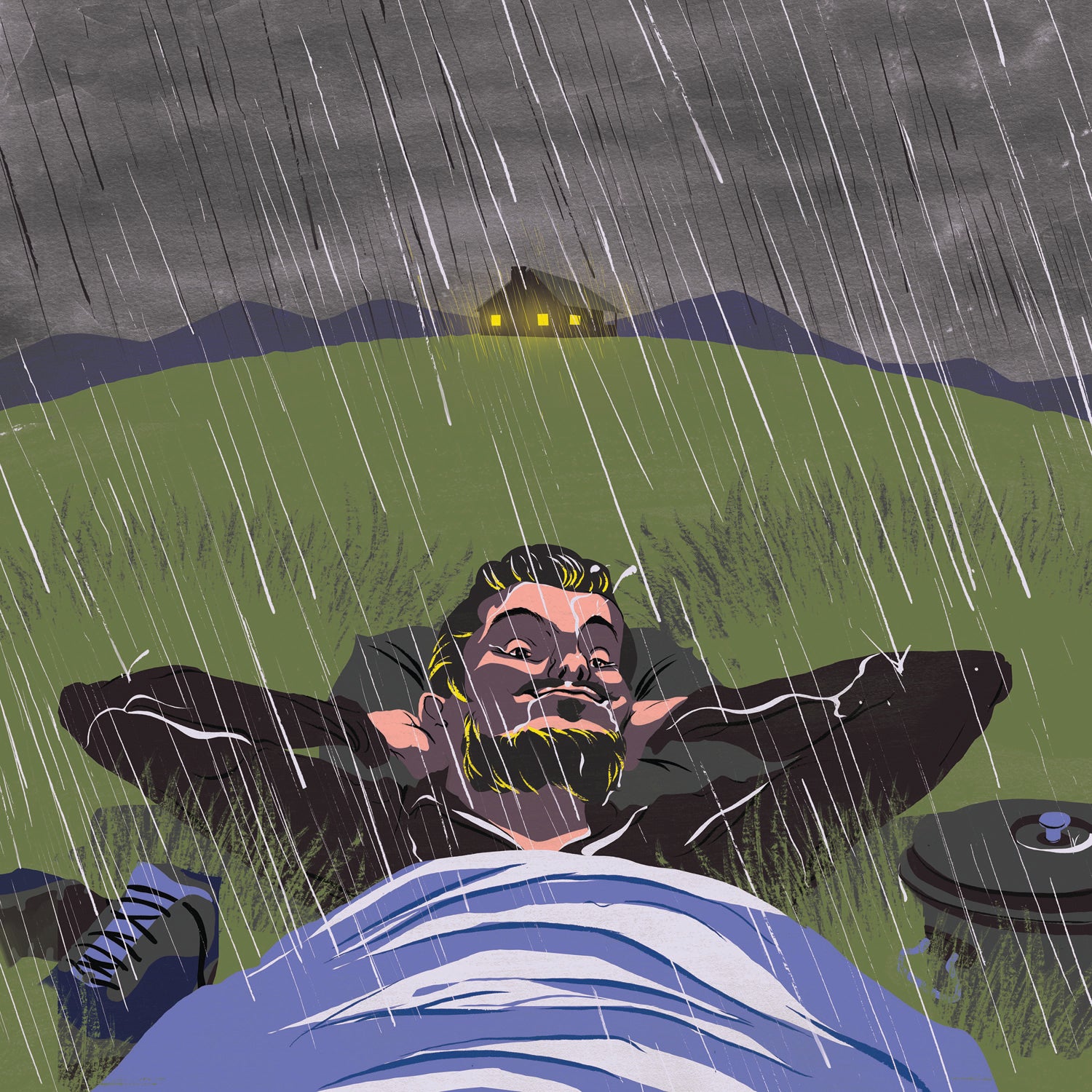When Shelter Means Stealing a Cabin

'Illustration by Ryan Garcia'
We stood in a circle around the seal. It was lying motionless, but still breathing, on a stretch of beach along Northern California’s Lost Coast. It looked up at us with big, sad eyes.
“It’s clearly suffering. I think we should kill it,” said John Harlin, this magazine’s Northwest editor at the time.
“What! Are you kidding?” answered contributing editor Mike Lanza.
He was not kidding. “I could just pound its head with a rock,” Harlin said. “You know, like a mercy killing.”
It was late November 2001 and the first day of a four-day trip to test gear. Our group of seven had set out that morning from Mattole Beach, some of us carrying more trepidation than others. It was the off-season for the Lost Coast and a storm was in the forecast. But even in the best weather, traversing the wilderness beach requires timing the tides for safe passage below stretches of rocky headlands. Throw in a storm surge and the route becomes impassable—or interesting, depending on how you look at things.
Rocky Mountain Editor Steve Howe had his take: “This is a bad omen,” he said as we stared down at the seal with the sun beating on its silky, black skin. Howe said keeping to the plan was foolhardy. But then, Howe’s a bit of a grumbler. And never mind we were testing down bags, teepees, tarps, and lightweight rainshells. “We are carrying all the wrong gear for this place,” Howe added, as if he was going to talk the rest of us out of it.
Not a chance. Our group was dominated by the three horsemen of optimism. There was Jonathan Dorn, the editor-in-chief whose meteorological instinct deviated so far from Howe’s that he was testing an ultralight poncho as both shell and shelter. Gear Editor Dennis Lewon was so unconcerned that he’d packed wood-burning camp stoves. And then there was Harlin, who regularly sought out the world’s most difficult mountaineering routes because, for him, the greater the challenge, the greater the fun. Fortunately for the seal, Harlin’s zeal for euthanasia didn’t pass group muster. We hiked beneath blue skies to our campsite along Cooskie Creek.
The next morning, we woke to a pounding storm. Vindication for Howe, but to his credit, he didn’t gloat. “Howe and Harlin have gone to see if there is a better way around the headlands!” Dorn shouted over the teepee-rattling gusts.
The scouts returned with bad news: There was no high route. Being more of a worst-case-scenario kind of person myself, I thought we should heed yesterday’s omen. “Well, we should stay here and wait it out,” I said. Howe agreed. Two others were on the fence. The optimists argued that if we got out of camp right then, we could cross the headland stretch when the tide was at its lowest. Positivity prevailed.
The several-mile traverse between Cooskie and Randall Creeks was worse than even I had imagined. A storm surge had pinned churning surf to cliffs. We struggled across slippery rocks where every oncoming wave felt like a fire hose. I planted my trekking poles between rocks to avoid being swept out to sea and looked back at our crew. Lewon was laughing. Howe was fuming. And Dorn had salvaged a buoy rope to secure his poncho around his waist. Meanwhile, the storm runoff caused rocks to drop from the cliffs overhead like mortar rounds.
Eventually we reached sanctuary—a treeless bluff well above the surf and lashed by the hurricane-force winds. Somehow, in the middle of this vast stretch, there was a cabin. It was the only windbreak in sight and so we huddled on the porch to consider our options.
“There is no way we can pitch tents in this wind,” said Howe, who added grimly that he was feeling hypothermic.
Lanza, with his jacket wet through, said he was soaked and maybe hypothermic, too. Everyone was shivering.
Howe turned the knob on the door of the cabin. It was unlocked.
“I’m going in,” I said without hesitation. Howe and Lanza followed.
But the three horsemen would have none of it. “That’s breaking and entering,” Dorn said, suddenly glowering.
“What about gear testing?” added Harlin, the seal sadist. “You’re cheating.”
Cheating never felt so good. We were finally out of the wind and rain. Our focus turned from survival to getting comfy. We brewed tea. We claimed bunks. And we laughed as we watched the optimists outside the cabin’s large picture window scurrying around looking for sticks to fuel their wood stove. (They had managed to erect their teepee in the lee of the cabin, which, somehow, was not cheating.)
With nightfall came a temperature drop. The cabin was unheated, while the fire in the teepee had turned it into a sweat lodge. The optimists were sitting shirtless, drying their clothes on a line. Our cohort of mutineers briefly visited the teepee and its smug occupants—to warm up. Sitting around the wood stove, we argued about who was smarter. Team Mutiny had the good judgment to get out of a potentially life-threatening situation. But the optimists argued they’d been right since they weren’t dead. They called us quitters.
We woke the next morning to a rainbow arching over the coastal bluffs. The storm had passed. We tidied up the cabin and got the owner’s address from a magazine cover so we could later send him a thank you note with a bottle of whiskey.
The rest of the hike went off without a hitch, notwithstanding a raccoon raid on the last night in which we lost what was left of our food. Once at the Black Sands Beach trailhead, we reflected in our disparate ways on what had gone down.
“Man, that was fun,” Lewon said.
“Well,” Lanza replied, “I’m just thankful Harlin didn’t club me in the head.”
Southwest Field Editor Annette McGivney lives in Arizona, far away from the beach.